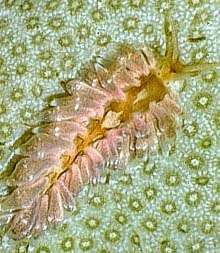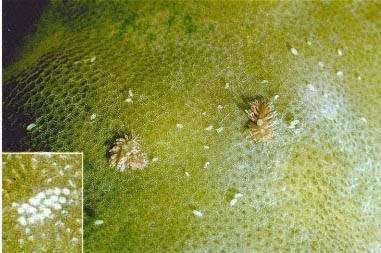
Cuthona poritophages
Rudman, 1979
Order: NUDIBRANCHIA
Suborder: AEOLIDINA
Family: Tergipedidae
DISTRIBUTION
Known only from East Africa.
PHOTO
Cuthona poritophages on Porites colony, 10mm long. Photo at LOWER RIGHT shows two animals with their egg masses, which are laid over the living coral colony. Africana Bch, 1km south of Kunduchi Bch, Dar es Salaam, Tanzania, June 1977. PHOTOS: Bill Rudman.
RELATED TOPIC
This small tergipedid grows to about 11mm. It has only been found on colonies of the coral Porites, on which it lives, feeds and lays its eggs. As most species of Cuthona live and feed on hydroid colonies, this species shows some interesting adaptions to its unique choice of food. Its radular teeth are about half the size of a similar-sized hydroid-feeding Cuthona enabling it to scrape the polyp tissue from each calyx of the coral skeleton. The cnidosac at the tip of each ceras is reduced and non-functional, (Porites nematocysts apparently being worthless for defence), but the epithelial wall at the tip of each ceras is packed with large osmiophil secretory cells apparently for defence.
Cuthona poritophages greatest adaptation is its very rapid life cycle. Adults are sexually mature within 3 weeks of hatching (5-7mm long). The egg masses contain up to 40 eggs which hatch in 5-7 days. Most veligers swim for about 10 minutes then settle on to part of the coral colony where within 30 minutes they have absorbed their velar lobes and within an hour have dropped their shell and metamorphosed into a tiny "slug". A few veligers can remain swimming for at least 4 days. Such variability will enable most larvae to settle on local colonies of Porites, but it also leaves a few larvae the useful ability to travel further afield. In one aquarium study I did in Tanzania, in a 6 week period, 6 animals produced about 120 offspring (in 2 bursts of egglaying). The combined efforts of the original six and their off-spring, resulted in the production of 720 egg masses (approx. 29,000 eggs)!
See other coral-feeding species: Phestilla lugubris, Phestilla minor
References.
• Rudman, W.B. (1979) The ecology and anatomy of a new species of aeolid opisthobranch mollusc: a predator of the reef-forming coral Porites. Zoological Journal of the Linnean Society 65: 339-359.
• Rudman, W.B. (1981) Further studies on the anatomy and ecology of opisthobranch molluscs feeding on the scleractinian coral Porites. Zoological Journal of the Linnean Society, 71: 373-412.


Rudman, W.B., 1999 (July 1) Cuthona poritophages Rudman, 1979. [In] Sea Slug Forum. Australian Museum, Sydney. Available from http://www.seaslugforum.net/find/cuthpori
Related messages
Cuthona cf. poritophages from American Samoa
January 11, 2002
From: Don Barclay

Hi Bill,
Here's one for you that I'm not going to hazard a guess on. It is tiny, around 4mm long, and was found crawling on a coral branch (Porites cylindrica?) in less than one meter of water, ~1730 local time, 13 July 2001, middle of Coconut Point, Nu'uuli, American Samoa.
The cerata appeared to mostly be paired, with two growing from about the same spot on the body. The irregular brown markings on the body seem to connect the first two pairs of cerata on each side. The body itself is mostly transparent, with an opaque white area in the middle toward the head. Can you identify it?
Thanks again,
Don Barclay
n5ols@samoatelco.com
Barclay, D., 2002 (Jan 11) Cuthona cf. poritophages from American Samoa. [Message in] Sea Slug Forum. Australian Museum, Sydney. Available from http://www.seaslugforum.net/find/4823Dear Don,
This has many similarities to Cuthona poritophages which feeds exclusively on species of the coral genus Porites. At present it is known only from eastern Africa but there is no reason why it couldn't have a wider geographic range. There are obvious differences. However the lack of pigmentation in your animal, and the small number of cerata, could be because your animal is a small juvenile. Finding it on a coral suggests it could be a coral feeder, especially when at such a small size it would be most likely to find it on its food. There is another clue however. If you look at the tips of its cerata, you will see they are rounded and the tip seems to be lined with white glands. The nematocysts in corals seem to be unsuitable for use in defence by aeolids [see page on cnidosacs] and all coral-feeding aeolids have instead a swollen glandular tip to their cerata such as this animal [see Coral Feeding - defensive adaptations].
To be sure we would need to look at some larger animals and probably their anatomy.
Best wishes,
Bill Rudman.
Cuthona poritophages - another coral-feeder
May 31, 1999
From: Bill Rudman
Here is a page on Cuthona poritophages, another Porites-feeding aeolid. I know of no records of it outside East Africa. If anyone has seen it elsewhere could they please let me know.
Bill Rudman.
